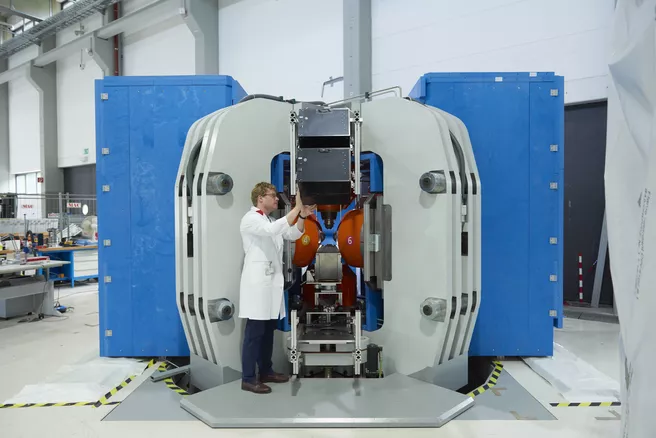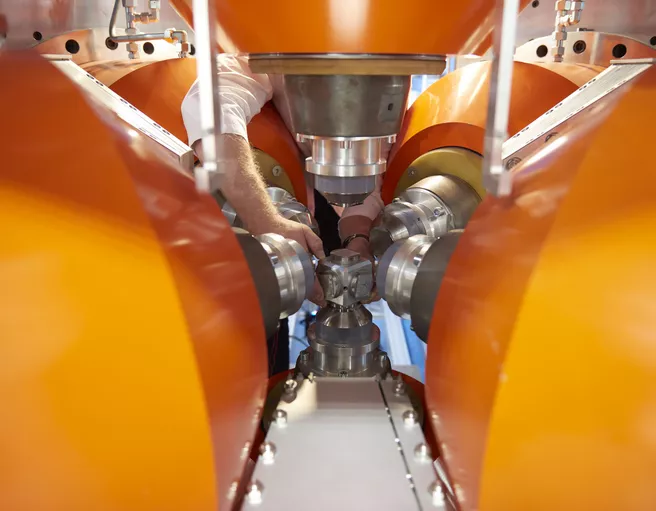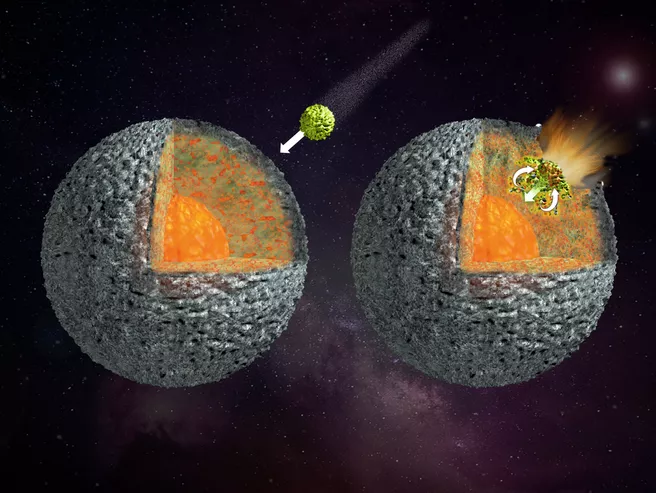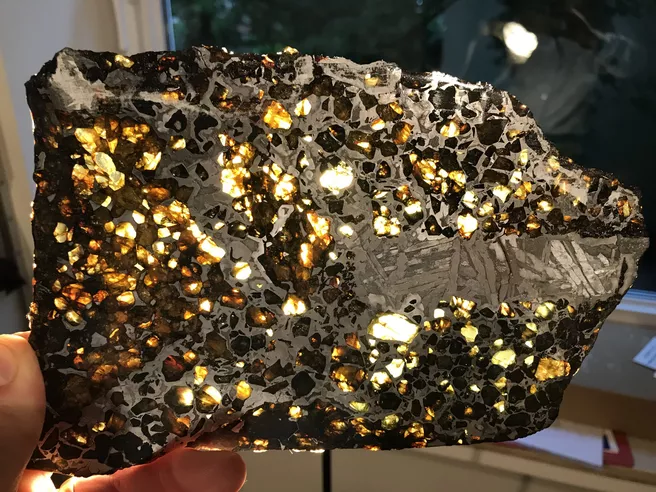"Pallasites are the optically most beautiful and unusual meteorites," says Dr. Nicolas Walte, the first author of the study, in an enthusiastic voice. They belong to the group of stony-iron meteorites and comprise green olivine crystals embedded in nickel and iron. Despite decades of research, their exact origins remained shrouded in mystery.
To solve this puzzle, Dr. Nicolas Walte, an instrument scientist at the Heinz Maier-Leibnitz Zentrum (MLZ) in Garching, together with colleagues from the Bavarian Geoinstitute at the University of Bayreuth and the Royal Holloway University of London, investigated the pallasite formation process. In a first, they succeeded in experimentally producing the structures of all types of pallasites.
Deployment of the SAPHiR instrument
For its experiments, the team used the SAPHiR multi-anvil press which was set up under the lead of Prof. Hans Keppler of the Bavarian Geoinstitute at the MLZ and the similar MAVO press in Bayreuth. Although neutrons from the FRM II have not yet been fed into SAPHiR, experiments under high pressures and at high temperatures can already be performed.
"With a press force of 2400 tons, SAPHiR can exert a pressure of 15 gigapascals (GPa) on samples at over 2000 °C," explains Walte. “That is double the pressures needed to convert graphite into diamond.” To simulate the collision of two celestial bodies, the research team required a pressure of merely 1 GPa at 1300 °C.
How are pallasites formed?
Until recently, pallasites were believed to form at the boundary between the metallic core and the rocky mantle of asteroids. According to an alternative scenario, pallasites form closer to the surface after the collision with another celestial body. During the impact molten iron from the core of the impactor mingles with the olivine-rich mantle of the parent body.
The experiments carried out have now confirmed this impact hypothesis. Another prerequisite for the formation of pallasites is that the iron core and rocky mantle of the asteroid have partially separated beforehand.
All this happened shortly after their formation about 4.5 billion years ago. During this phase, the asteroids heated up until the denser metallic components melted and sank to the center of the celestial bodies.
The key finding of the study is that both processes – the partial separation of core and mantle, and the subsequent impact of another celestial body – are required for pallasites to form.
Insights into the origins of the solar system
“Generally, meteorites are the oldest directly accessible constituents of our solar system. The age of the solar system and its early history are inferred primarily from the investigation of meteorites,” explains Walte.
“Like many asteroids, the earth and moon stratified into multiple layers, consisting of core, mantle and crust,” says Nicolas Walte. “In this way, complex worlds were created through the agglomeration of cosmic debris. In the case of the earth, this ultimately laid the foundations for the emergence of life."
The high-pressure experiments and the comparison with pallasites highlight significant boundary conditions for processes that transpired in the early solar system. The team's experiments provide new insights into the collision and material mixing of two celestial bodies and the subsequent rapid cooling down together. This will be investigated in more detail in future studies.
Original publication:
Two-stage formation of pallasites and the evolution of their parent bodies revealed by deformation experiments. Nicolas P. Walte, Giulio F. D. Solferino, Gregor J. Golabek, Danielle Silva Souza, Audrey Bouvier. Earth and Planetary Science Letters, Vol. 546, 15 September 2020, 116419 – DOI: 10.1016/j.epsl.2020.116419
Further information:
The research was funded by the German Federal Ministry of Education and Research (BMBF).
Contact:
Dr. Nicolas P. Walte
Technische Universität München
Forschung-Neutronenquelle Heinz Maier-Leibnitz
Instrument SAPHiR
Lichtenbergstr. 1, 85748 Garching
Tel.: 089 / 289-11772 – E-Mail: nicolas.walte(at)frm2.tum.de
Web: https://mlz-garching.de/saphir/de



